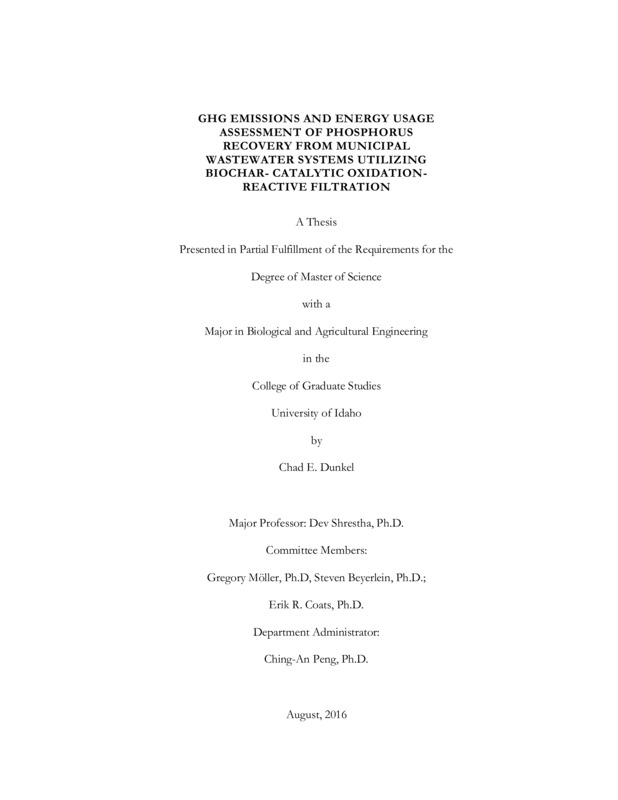GHG EMISSIONS AND ENERGY USAGE ASSESSMENT OF PHOSPHORUS RECOVERY FROM MUNICIPAL WASTEWATER SYSTEMS UTILIZING BIOCHAR-CATALYTIC OXIDATION-REACTIVE FILTRATION
Dunkel, Chad. (2016). GHG EMISSIONS AND ENERGY USAGE ASSESSMENT OF PHOSPHORUS RECOVERY FROM MUNICIPAL WASTEWATER SYSTEMS UTILIZING BIOCHAR-CATALYTIC OXIDATION-REACTIVE FILTRATION. Theses and Dissertations Collection, University of Idaho Library Digital Collections. https://www.lib.uidaho.edu/digital/etd/items/dunkel_idaho_0089n_10992.html
- Title:
- GHG EMISSIONS AND ENERGY USAGE ASSESSMENT OF PHOSPHORUS RECOVERY FROM MUNICIPAL WASTEWATER SYSTEMS UTILIZING BIOCHAR-CATALYTIC OXIDATION-REACTIVE FILTRATION
- Author:
- Dunkel, Chad
- Date:
- 2016
- Keywords:
- Biochar Catalytic oxidation Energy Life Cycle Assessment Reactive filtration Water Treatment
- Program:
- Biological & Agricultural Engineering
- Subject Category:
- Agriculture engineering; Engineering
- Abstract:
-
The Nutrient-Energy-Water Technology (NEW TechTM) system is an emerging wastewater treatment process with the primary objective of addressing the food-energy-water nexus. The system uses biochar- catalytic oxidation- reactive filtration as the means of recovering phosphorus by adsorption onto biochar and producing clean reusable H20 from wastewater resources. Nutrient enriched biochar used as a soil amendment will sequester carbon from the atmosphere, while offsetting the demand for fertilizers produced through mining and industrial processing.
Emissions and energy analysis includes a detailed analysis and benchmark of the energy required to operate the system, energy efficiency optimization opportunities, and an analysis of greenhouse gas emissions produced as a result of system operations in the treatment of post-secondary treatment municipal wastewater. Currently, the NEW TechTM system can achieve full operations utilizing approximately 6.3 kW of electricity and is capable of processing 1000 gallons of waste water for 0.68 dollars. Furthermore, the system has state-of-the-art removal of total phosphorus to 0.004 mg/L when treating secondary municipal waste water. Additionally, greenhouse gas analysis determined that the system electrical and material usage produces approximately 3.3 kg of CO2 per 1000 gallons of water processes.
Energy and greenhouse gas emissions savings can be realized via the implementation of energy efficiency improvements to process equipment. Energy savings identified could lower energy usage costs to approximately $0.44 per 1000 gallons and reduce the global warming potential of the overall system to 2.69 kg of CO2 produced.
- Description:
- masters, M.S., Biological & Agricultural Engineering -- University of Idaho - College of Graduate Studies, 2016
- Major Professor:
- Shrestha, Dev
- Committee:
- Moller, Greg; Beyerlein, Steven; Coats, Erik
- Defense Date:
- 2016
- Identifier:
- Dunkel_idaho_0089N_10992
- Type:
- Text
- Format Original:
- Format:
- application/pdf
- Rights:
- In Copyright - Educational Use Permitted. For more information, please contact University of Idaho Library Special Collections and Archives Department at libspec@uidaho.edu.
- Standardized Rights:
- http://rightsstatements.org/vocab/InC-EDU/1.0/

